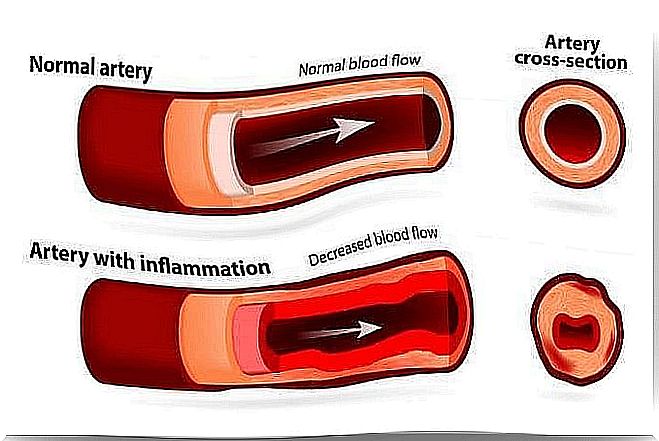Takayasu’s Arteritis: Inflammation That Affects The Large Vessels
Takayasu’s arteritis is an inflammation that affects the large vessels. Today we will see in depth what this condition consists of and how it can be solved.

Takayasu arteritis is a very rare type of vasculitis. This disease causes inflammation in the major blood vessels, that is, the aorta and its main branches. This is a serious problem as the inflammation damages the aorta.
This type of disease can cause blockages, stenosis, and even aneurysms. Therefore, it is important to attend to your symptoms. The problem arises when the person who has Takayasu’s arteritis does not present any symptoms.
The normal thing in cases in which there are no symptoms is that no treatment is needed because the problem is not very serious and there is only slight inflammation. With medication it can be controlled.
Stages of Takayasu arteritis
Takayasu arteritis evolves in two distinct stages. Each of them presents a different symptomatological picture, although we are going to take into account some considerations that are necessary.
However, before it is important to mention that this type of arteritis usually affects women between 30 and 40 years old. Although, as we well know, there can always be exceptions since this is not an exact science.

Stage 1
In the first stage of Takayasu’s arteritis, nothing tells us that we are suffering from this type of disease. In fact, the symptoms that will manifest may be confused with other common diseases:
- Fatigue: can be considered the result of a vitamin deficiency or a very stressful period.
- Involuntary weight loss: if we suffer from hypothyroidism we can believe that this symptom comes from this condition.
- General aches or pains: we can confuse them with eating something that has made us feel bad, having poor circulation or having exercised.
- Mild fever: it is most likely that we associate it with the beginning of the flu.
As we can see, nothing would make us suspect that we are suffering from Takayasu’s arteritis. In some cases, some people have no symptoms at all during this early stage or they are very subtle.
The big problem with missing these symptoms or not treating Takayasu’s arteritis as quickly as possible is that our arteries can become damaged over time. When we find out, they may be in a very dire situation.
Also visit: The different treatments for high blood pressure
Stage 2
If we go through the previous stage without realizing that we have a principle of Takayasu arteritris, it is most likely that we will end up in stage 2. In this stage, the symptomatological picture is quite different and it will urge us to ask for help.
- We will suffer extreme weakness in the limbs after using them.
- We will have headaches accompanied by memory problems and thinking difficulties.
- We can feel lightheaded, dizzy, and even faint for no apparent reason.
- We will suffer chest pain that we can confuse with a sign of a heart attack.
The positive thing about all these symptoms is that they will lead us to seek medical help. When the doctor tests us, there will be other types of warning signs that will indicate that we are facing a case of Takayasu arteritris.
For example, the blood pressure in our arms will be different, we will have a fairly low pulse and, most likely, we will suffer from anemia. This is all due to the fact that in this second stage the narrowing of the arteries is noticeable. Due to this, there is a lower flow of blood, oxygen and nutrients which causes all the mentioned symptoms.
You may be interested: How to prevent a stroke by following 6 tips
Takayasu arteritis treatment
Left untreated, Takayasu’s arteritis can lead to inflammation of the heart, heart failure, aortic aneurysm, or stroke. Therefore, the sooner we detect this disease, the sooner we can start treatment.
- Pharmacological treatment: it focuses on controlling inflammation that can cause serious damage to the major vessels.
- Treatment with surgery: through angioplasty the arteries that have been narrowed are unblocked, restoring blood flow.
- Combined treatment: in the most advanced stages of the disease, combining drugs with surgery allows for better results.
As we have seen, detecting Takayasu’s arteritis early is essential so that this disease does not cause us more serious problems. Taking care of the symptoms and going to the doctor without assuming that it is a common disease will help us to solve it as soon as possible.








